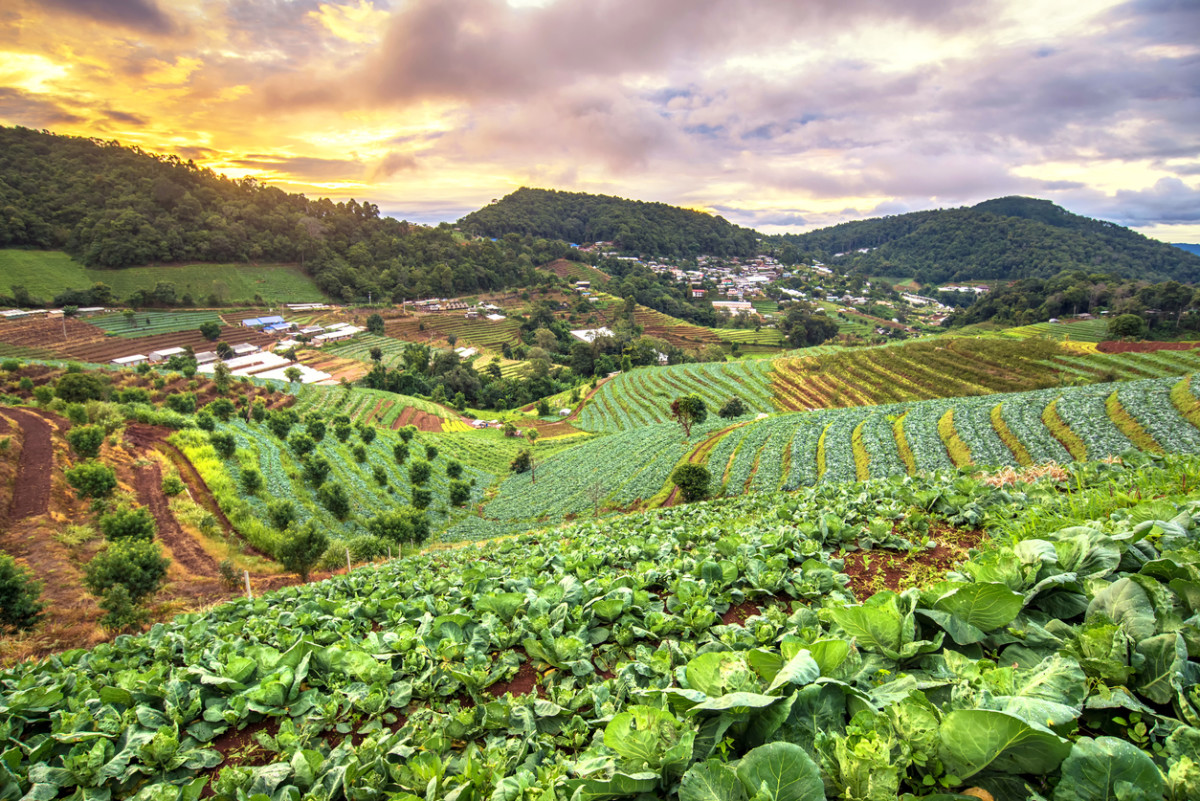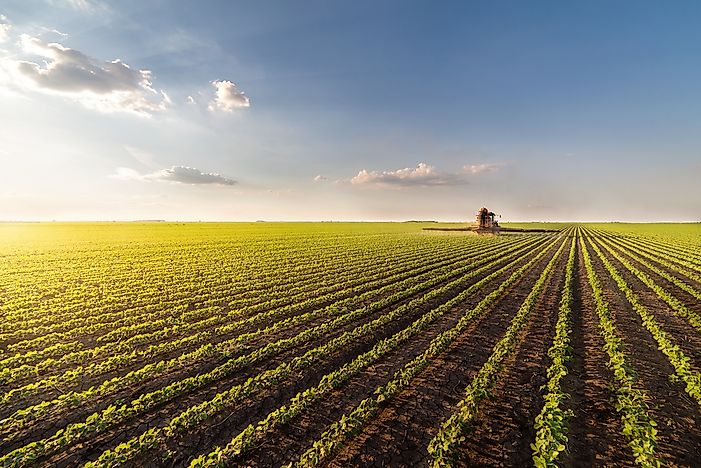Sustainable Agriculture
Sustainable agriculture is farming in sustainable ways (meeting society's food and textile needs in the present without compromising the ability of future generations to meet their own needs) based on an understanding of ecosystem services, the study of relationships between organisms and their environment. Agriculture sustainability is also involved with the social and environmental factors.
Importance Of Sustainable Farming:
Sustainable agriculture is the best way to feed the world a highly growing population by using limited resources and getting the maximum advantages. Agriculture plays an important role in our life because we almost completely rely on agriculture for our needs ( Importance Of Agriculture). Sustainable agricultural practices are intended to protect the environment, expand the Earth's natural resource base, and maintain and improve soil fertility. Based on a multi-pronged goal, sustainable agriculture seeks to: Increase profitable farm income. Sustainable agriculture provides a chance to the small landholding farmers to establish their business by using limited resources. (Business Ideas)
Advantages of Sustainable Agriculture:
Sustainable agriculture also benefits the environment by maintaining soil quality, reducing soil degradation and erosion, and saving water. In addition to these benefits, sustainable agriculture also increases the biodiversity of the area by providing a variety of organisms with healthy and natural environments to live in. Few important points are given below;
- Provide maximum Output on limited Resources
- Conservation of Environment
- Enhance the nutritional value of food
- Can Feed world Large Population
Basic Principles Of (SA):
There are several principles associated with sustainability in agriculture. To perform successful farming you need to know about the factors which influence the plant growth and the modern agricultural techniques(Modern Technologies In Agriculture)
- The incorporation of biological and ecological processes into agricultural and food production practices. For example, these processes could include nutrient cycling, soil regeneration, and nitrogen fixation.
- Using decreased amounts of non-renewable and unsustainable inputs(Land, Fertilizers, Pesticides, Water, etc)particularly the ones that are environmentally harmful.
- Using the expertise of farmers to both productively work the land as well as to promote the self-reliance and self-sufficiency of farmers.
- Solving agricultural and natural resource problems through the cooperation and collaboration of people with different skills. The problems tackled include pest management and irrigation.
Methods Of Sustainable Farming:
What grows where and how it is grown is a matter of choice. Two of the many possible practices of sustainable agriculture are crop rotation and soil amendment, both designed to ensure that crops being cultivated can obtain the necessary nutrients for healthy growth. Soil amendments would include using locally available compost from community recycling centers. These community recycling centers help produce the compost needed by the local organic farms
Using community recycling from yard and kitchen waste utilizes a local area's commonly available resources. These resources in the past were thrown away into large waste disposal sites, are now used to produce low-cost organic compost for organic farming. Other practices include growing a diverse number of perennial crops in a single field, each of which would grow in separate seasons so as not to compete with each other for natural resources. This system would result in increased resistance to diseases and decreased effects of erosion and loss of nutrients in the soil. Nitrogen fixation from legumes, for example, used in conjunction with plants that rely on nitrate from the soil for growth, helps to allow the land to be reused annually. Legumes will grow for a season and replenish the soil with ammonium and nitrate, and the next season other plants can be seeded and grown in the field in preparation for harvest.
Poly-culture:
Mono-culture:
A method of growing only one crop at a time in a given field is a very widespread practice, but there are questions about its sustainability, especially if the same crop is grown every year. Today it is realized to get around this problem local cities and farms can work together to produce the needed compost for the farmers around them. This combined with growing a mixture of crops (poly-culture) sometimes reduces disease or pest problems but poly-culture has rarely, if ever, been compared to the more widespread practice of growing different crops in successive years (crop rotation) with the same overall crop diversity. Such methods may also support sustainable weed management in that the development of herbicide-resistant weeds is reduced. Cropping systems that include a variety of crops (poly-culture and/or rotation) may also replenish nitrogen (if legumes are included) and may also use resources such as sunlight, water, or nutrients more efficiently. There so much advance equipment that is used to perform many operations on the farmland.
Impacts Of Sustainable Agriculture:
- Off-Farm Impacts:
A farm that is able to "produce perpetually", yet has negative effects on environmental quality elsewhere is not sustainable agriculture. An example of a case in which a global view may be warranted is over-application of synthetic fertilizer or animal manures, which can improve the productivity of a farm but can pollute nearby rivers and coastal waters (eutrophication). The other extreme can also be undesirable, as the problem of low crop yields due to exhaustion of nutrients in the soil has been related to rain forest destruction, as in the case of slash and burn farming for livestock feed. In Asia, specific land for sustainable farming is about 12.5 acres which includes land for animal fodder, cereals productions lands for some cash crops and even recycling of related food crops. In some cases even a small unit of aquaculture is also included in this number (AARI-1996).
Sustainability affects overall production, which must increase to meet the increasing food and fiber requirements as the world's human population expands to a projected 9.8 billion people in 2050.
- Anthropogenic Changes:
- Side Effects And Externalities :
There is not a lot of data on the environmental and health costs that are caused by agriculture influence on other segments; the misuse of natural resources is one such example. These undesirable outcomes are labeled as externalities. Their costs are not part of market prices because they are non-market issues. Negative externalities occur because of market failures, where a contaminator is penalized for the damage caused to the environment; these costs that are never paid are external costs. In the agriculture sector, these externalities have four aspects: the cost of them is ignored by the unlawful party; they happen within long intervals; susceptible populations with little to no political or decision altering power are negatively affected; the source of the external factor is not always deduced. This lack of concise information flow means that the economic cost of the externalities is debated in the agricultural industry. As a result of this, modern agriculture has contributed to increased environmental and health issues; documented cases of these issues are nations such as, Ecuador, China, Germany, the Philippines, the UK, as well as the USA. These developments have made nations contemplate what the best and most efficient systems of agriculture are. In the Philippians for example, methodologies free of pesticides contribute to net social benefits. Externalities of pesticide use in China are responsible for 1.4 billion dollars cost per year because of the increased need for health services to the general population; as well as negative impacts on biodiversity.
Related topics:
Benefits Of Raw Honey, Most Valuable cash crops in the world, Dairy Business Guidelines



Arslan Arshad
ReplyDeleteIndia's agriculture is composed of many crops, with the foremost food staples being rice and wheat. Indian farmers also grow pulses, potatoes, sugarcane, oilseeds, and such non-food items as cotton, tea, coffee, rubber, and jute (a glossy fiber used to make burlap and twine). India is a fisheries giant as well. A total catch of about 3 million metric tons annually ranks India among the world's top 10 fishing nations. Despite the overwhelming size of the agricultural sector, however, yields per hectare of crops in India are generally low compared to international standards. Improper water management is another problem affecting India's agriculture. At a time of increasing water shortages and environmental crises, for example, the rice crop in India is allocated disproportionately high amounts of water. One result of the inefficient use of water is that water tables in regions of rice cultivation, such as Punjab, are on the rise, while soil fertility is on the decline. Aggravating the agricultural situation is an ongoing Asian drought and inclement weather. Although during 2000-01 a monsoon with average rainfall had been expected, prospects of agricultural production during that period were not considered bright. This has partially been due to relatively unfavorable distribution of rainfall, leading to floods in certain parts of the country and droughts in some others.
ReplyDeleteIndian Agriculture.
Despite the fact that agriculture accounts for as much as a quarter of the Indian economy and employs an estimated 60 percent of the labor force, it is considered highly inefficient, wasteful, and incapable of solving the hunger and malnutrition problems. Despite progress in this area, these problems have continued to frustrate India for decades. It is estimated that as much as one-fifth of the total agricultural output is lost due to inefficiencies in harvesting, transport, and storage of government-subsidized crops.
India is the donor of practically 1.8% of the world's fleece creation. When characterizing the various sorts of agro-based industry or setting up a rundown of agro-based items, comprehend that the woolen material industry is additionally isolated into ten significant classifications - woolen yarn, fleece tops, texture (woolen/worsted), worsted yarn, terrible yarn, disgraceful textures, covers, knitwear, hand-made covers, and machine-made rugs. Vakilsearch site to agriculture business opportunities
ReplyDeleteThe blog is really good. Thanks for sharing it. luggage weighing scale
ReplyDelete